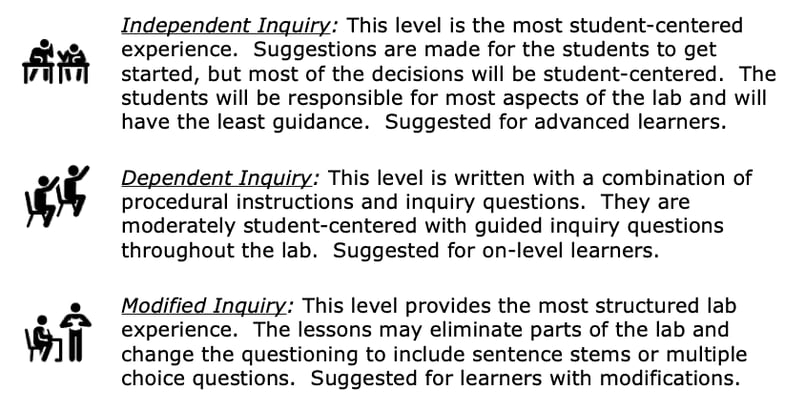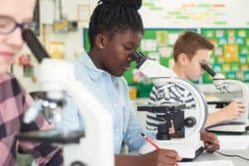Acids and Bases Inquiry Lab
Middle School Inquiry Lab on Acids and Bases
In this lab students will use cabbage juice as an indicator to conduct pH tests on common household materials.
Each inquiry lab will contain an essential question that will drive the lesson and make students think. For this lesson, the essential question is:
- What are the differences between acids and bases?
BACKGROUND INFORMATION AND MATERIALS LIST:
Students will begin the lab by reading the essential question and background information. This can be done individually, as lab groups, or as a whole class. If you consider lab groups, you also might include some type of whole class formative checks before digging into the lab.

Materials List:
- safety goggles
- cabbage juice indicator
- 8 portion cups
- 8 toothpicks
- 1 tablespoon sugar solution*
- 1 tablespoon baking powder solution*
- 1 tablespoon white vinegar*
- 1 tablespoon lemon-lime soda
- 1 tablespoon lemon juice
- 1 tablespoon hand sanitizer
- 1 tablespoon distilled water
- 1 tablespoon milk
- pipette
- goggles
- color pH scale (wait to distribute!)
- colored pencils
PROCEDURE:
Wearing proper eye protection, students will be using the cabbage juice as an indicator to determine where common household products fall on the pH scale. Students will label their portion cups with the materials identified in the lesson and will have to add drops of the cabbage juice indicator. Almost instantaneously, students should see the color of the product change the color of the cabbage juice. Using clean toothpicks, students will gently stir each mixture and record their findings on a table provided.
After they completed recording their findings, students are to organize the mixture colors from pink to greenish. Using the pH indicator card provided by the teacher, students will compare their findings with what the card shows.
CHECK FOR UNDERSTANDING:
At this point in the lab, students will be checked for understanding by answering questions about their findings. An example of such a question could be:
- Compare your portion cups to the actual pH scale of the household substances given to you by your teacher, how do your results compare?
CONCLUSION
Students will go back to the essential question and write a CER (Claim, Evidence, Reasoning) to conclude the lab. Once completed, students will reflect back on their learning by answering the following questions:
- You take a sip of an unknown substance and noticed that it tastes sour. What can you infer about the substance?
- Bee stings are acidic in nature. A household remedy for a bee sting is baking soda, which is a basic substance. What is happening to the pH of the bee sting when the baking soda is applied?
MODIFIED AND INDEPENDENT INQUIRY VERSIONS
All of the Kesler Science inquiry labs come with three different modification levels. Each lab is differentiated using the icons below.

Download Over $100 in FREE Resources
For Middle School Science
Simply create a login below and gain immediate access to a selection of our Kesler Science product line worth $100 - for FREE. There's a full version of every product type! You'll also join tens of thousands of middle school science teachers who receive timely tips and strategies straight to their inbox.






